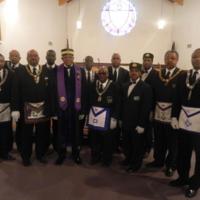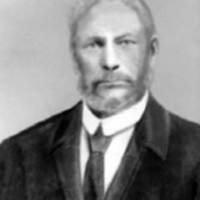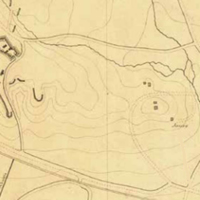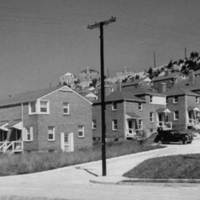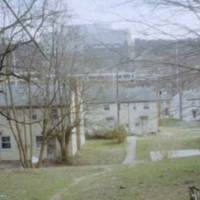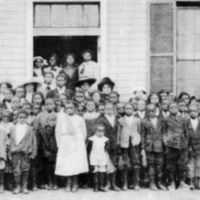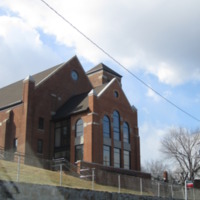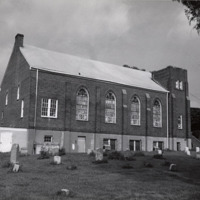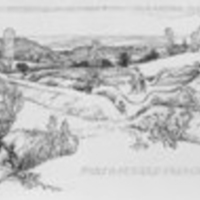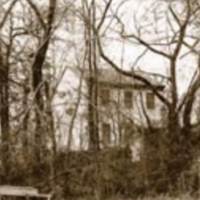Browse Items (10 items total)
Arlington's African American Masonic Lodge No. 58 was founded in the Green Valley community in 1888. The institution provided Arlington's growing black community with social, fraternal, and political support. Early members included community leaders Henry Louis Holmes and Edmund C. Fleet. The image above shows current members in the Masonic Lodge at their 2013 sunrise service.
Collection: Community Institutions
William A. Rowe escaped enslavement and fled to Freedman's Village in Arlington, where he became a prominent community leader. Rowe was trained as a blacksmith in the Village and became a particularly successful African American politician. He served as Supervisor of Jefferson District from 1871 to 1879 and even served as Board chairman from 1872 to 1883. After the closure of Freedman's Village, Rowe relocated to Green Valley in 1879 with his wife and three children. Rowe quickly re-established his role as a local political leader in his new community, serving as the area's Supervisor.
Collection: Neighborhoods
In 1844 Sarah and Levi Jones purchased 14 acres of land in eastern Arlington along Four Mile Run to farm and build a home. Their property, labeled "Jones," can be seen at the center of the map above. Throughout the decades before and after the Civil War, the Jones family expanded their farm, sold land to fellow African Americans to help create the Green Valley neighborhood, and became community leaders.
Little is known about Sarah's life before 1844, but Levi was born free in Fairfax, Virginia. His parents, Davy and Evy, were enslaved on George Washington's Mount Vernon plantation.
Little is known about Sarah's life before 1844, but Levi was born free in Fairfax, Virginia. His parents, Davy and Evy, were enslaved on George Washington's Mount Vernon plantation.
Collection: Neighborhoods
First established in 1844 by freemen Sarah and Levi Jones, Green Valley is Arlington's oldest African American community. By 1900 this neighborhood in eastern Arlington County became the largest black community in terms of both geography and population. This large population supported both a church and school within the community. The early strength of Green Valley was due, in large part, to the presence of the Jones family who actively sold land to fellow African Americans. The image above shows the community in the 1970s. At that time the community became known as Nauck.
Collection: Neighborhoods
During World War Two the federal government created six segregated barracks style wartime emergency housing neighborhoods. One of these facilities was the 11-acre Paul Dunbar Homes complex in the Green Valley community, today called Nauck.
Here 86 African American households build a community. Following the war, Arlington officials wanted to tear the neighborhood down. Dunbar residents created the Dunbar Mutual Homes Association which they used to pool their resources, secure a loan, and turn Dunbar Homes into a community dedicated to providing affordable housing. Dunbar Homes was demolished in 2005 to make way for luxury town-homes.
Here 86 African American households build a community. Following the war, Arlington officials wanted to tear the neighborhood down. Dunbar residents created the Dunbar Mutual Homes Association which they used to pool their resources, secure a loan, and turn Dunbar Homes into a community dedicated to providing affordable housing. Dunbar Homes was demolished in 2005 to make way for luxury town-homes.
Collection: Neighborhoods
Kemper School was the African American school for the the Green Valley community, Kemper opened in 1875 within Green Valley's AME Zion Church. Upon it's opening, Kemper was one of three schools for African American children, joining schools in the black communities of Hall's Hill and Freedman's Village.
In 1885 the school moved to a one-story, wood-frame school house on 3/4 of an acre of land. The school was named for Virginia Governor James L. Kemper who supported education for African Americans. By 1893 the school had outgrown its original structure and a new brick, two-story school house was created by Noble Thomas, the first black contractor in the county. In 1944 the school expanded further with the addition of the Kemper Annex, which was renamed Drew in 1955 in honor of leading African American blood plasma researcher and Arlington resident Dr. Charles Drew.
In 1964 Kemper ceased to function as a school, replaced by the larger Drew School. The building was demolished in the 1980s to make room for partially subsidized town-homes.
In 1885 the school moved to a one-story, wood-frame school house on 3/4 of an acre of land. The school was named for Virginia Governor James L. Kemper who supported education for African Americans. By 1893 the school had outgrown its original structure and a new brick, two-story school house was created by Noble Thomas, the first black contractor in the county. In 1944 the school expanded further with the addition of the Kemper Annex, which was renamed Drew in 1955 in honor of leading African American blood plasma researcher and Arlington resident Dr. Charles Drew.
In 1964 Kemper ceased to function as a school, replaced by the larger Drew School. The building was demolished in the 1980s to make room for partially subsidized town-homes.
Collection: Community Institutions
Mount Zion Baptist Church is a brick structure which features a gabled roof and right form tower.
The church congregation was originally founded within the Old Bell Church in Freedman's Village in 1866. In the late-1860s the Old Bell Church was demolished and the church split into two congregations - Mt. Olive and Mt. Zion Baptist churches. Both formed in the community of Queen City. In 1942 the federal government condemned the church and surrounding community to make way for the road networks of the Pentagon. The congregation moved to Green Valley where they opened the current church in July on 1945.
The church congregation was originally founded within the Old Bell Church in Freedman's Village in 1866. In the late-1860s the Old Bell Church was demolished and the church split into two congregations - Mt. Olive and Mt. Zion Baptist churches. Both formed in the community of Queen City. In 1942 the federal government condemned the church and surrounding community to make way for the road networks of the Pentagon. The congregation moved to Green Valley where they opened the current church in July on 1945.
Collection: Community Institutions
The Lomax Afro Methodist Episcopal (AME) Zion Church is a 45' x 72' two-story, gabled roof, brick structure. The church features a small cemetery to the right side where approximately 50 church members and community leaders were interred from the 1880s to 1965.
The church first began as Little Zion Methodist Church in Freedman's Village in 1866. In the 1880s the congregation moved to Green Valley. Before a new church building could be created services were held in the home of community leaders Levi and Sarah Ann Jones. In 1876 a one acre plot was purchased for $75 and a new church, now called Lomax AME Zion, was constructed, using wood preserved from the original Freedman's Village structure. The church was expanded in 1889 and in 1922 the present building was completed.
The church first began as Little Zion Methodist Church in Freedman's Village in 1866. In the 1880s the congregation moved to Green Valley. Before a new church building could be created services were held in the home of community leaders Levi and Sarah Ann Jones. In 1876 a one acre plot was purchased for $75 and a new church, now called Lomax AME Zion, was constructed, using wood preserved from the original Freedman's Village structure. The church was expanded in 1889 and in 1922 the present building was completed.
Collection: Community Institutions
In 1861 the Fort Barnard Fortifications were constructed as part of the Civil War defenses of Washington in Green Valley. The fort was named for General J.G. Barnard, the chief engineer for the defenses of Washington. The fort had significant earth works and gun platforms which featured twelve 24-32 pounder guns. During the war the fort was occupied by the 3rd Artillery Battery of the New York and the 14th of Massachusetts.
In 1902 the site was preserved as a park and community playground.
In 1902 the site was preserved as a park and community playground.
Collection: Community Institutions
Levi Jones and his wife Sarah were two of the earliest settlers of Green Valley, today known as Nauck.
In 1844 the couple built a 14' x 16', two story log cabin. During the Civil War, federal troops destroyed their original home. But following the war they were able to rebuild, creating the home pictured here.
The Jones were influential community leaders. Before other accommodations could be made, they hosted church services in their home. They sold land to freed slaves following the Civil War. These sales, along with interest from Washington, D.C. land speculator John Nauck, a white businessman who sold land to African Americans in the Green Valley area, strengthened and expanded the black community there. Their impact on Nauck's black community continued into the twentieth century, when the federal government built the Paul Dunbar Homes on 11 of their original homestead in 1942.
Levi and Sarah had two sons, Levi and Isaac, and three daughters, Mary, Martha, and Louise. Levi died in 1886 and Sarah followed in 1913 at the age of 95. They are buried at the Lomax AME Cemetery.
In 1844 the couple built a 14' x 16', two story log cabin. During the Civil War, federal troops destroyed their original home. But following the war they were able to rebuild, creating the home pictured here.
The Jones were influential community leaders. Before other accommodations could be made, they hosted church services in their home. They sold land to freed slaves following the Civil War. These sales, along with interest from Washington, D.C. land speculator John Nauck, a white businessman who sold land to African Americans in the Green Valley area, strengthened and expanded the black community there. Their impact on Nauck's black community continued into the twentieth century, when the federal government built the Paul Dunbar Homes on 11 of their original homestead in 1942.
Levi and Sarah had two sons, Levi and Isaac, and three daughters, Mary, Martha, and Louise. Levi died in 1886 and Sarah followed in 1913 at the age of 95. They are buried at the Lomax AME Cemetery.
Collection: Neighborhoods
